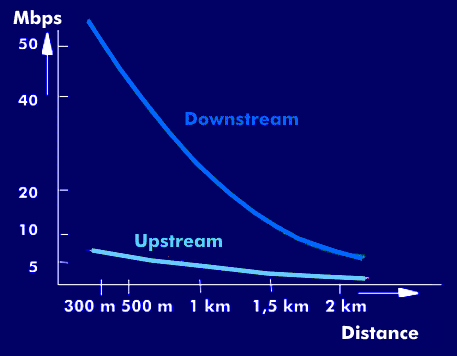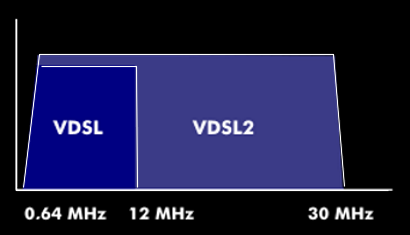very high speed digital subsciber line (VDSL)
VDSL technology was developed specifically for use in hybrid fiber/copper cable networks in access networks. This technology is used wherever symmetrical or asymmetrical data streams have to be transmitted at high speed over shorter distances. VDSL (Very High Speed Digital Subscriber Line) is a complement to ADSL (Assymetric) and SDSL (Symmetric), towards higher transmission speeds.
The aim of VDSL technology is to use existing telephone cable structures in the deployment scenarios of Fiber to the Home( FTTH) and Fiber to the Curb( FTTC) for high-speed transmissions. With VDSL, data transmission ratesare significantly increased compared with other DSL methods. With symmetrical transmission, total bit rates of up to 72 Mbit/s are achieved. VDSL operates in the frequency range between 138 kHz and 12 MHz using quadrature amplitude modulation( QAM). The frequency range is divided into two upstream and two downstream ranges.
VDSL distinguishes between asymmetrical and symmetrical transmission, with sum bit rates of 8 Mbit/s, 16 Mbit/s and 28 Mbit/s achieved in asymmetrical operating mode and sum bit rates of 12, 24, 48 and 72 Mbit/s in symmetrical transmission.
High-speed technology for HDTV
This technology can therefore also be used for the transmission of high-definition television( HDTV). With VDSL, transmission speeds of 13 Mbit/s to 52 Mbit/s are achieved in the downstream, i.e. from the node to the user, via copper twisted pairs. Upstream transmission speeds range from 1.5 Mbit/s to 2.3 Mbit/s.
VDSL is divided into three ranges in terms of coverage: Long Range between 1,000m and 1,500m, Mid Range between 300m and 500m, and Short Range below 300m. Long-range technology, LR-VDSL, uses the frequency band between 25 kHz and 138 kHz.
VDSL is specified by a wide variety of standardization bodies and forums, on the one hand by the European Telecommunications Standards Institute( ETSI), American National Standards Institute( ANSI) and the International Telecommunication Union( ITU), and on the other by the ADSL Forum, the VDSL Coalition and the Full Service Access Network( FSAN), an initiative of telecoms and manufacturers. The standard for VDSL was adopted in mid-2005.
With VDSL2, the ITU-T has adopted a standard for symmetrical transmission with data rates of 100 Mbit/s over 200 m and 500 m.



